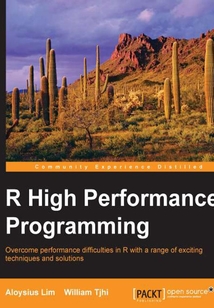目錄(77章)
倒序
- coverpage
- R High Performance Programming
- Credits
- About the Authors
- About the Reviewers
- www.PacktPub.com
- Support files eBooks discount offers and more
- Preface
- What this book covers
- What you need for this book
- Who this book is for
- Conventions
- Reader feedback
- Customer support
- Chapter 1. Understanding R's Performance – Why Are R Programs Sometimes Slow?
- Three constraints on computing performance – CPU RAM and disk I/O
- R is interpreted on the fly
- R is single-threaded
- R requires all data to be loaded into memory
- Algorithm design affects time and space complexity
- Summary
- Chapter 2. Profiling – Measuring Code's Performance
- Measuring total execution time
- Profiling the execution time
- Profiling memory utilization
- Monitoring memory utilization CPU utilization and disk I/O using OS tools
- Identifying and resolving bottlenecks
- Summary
- Chapter 3. Simple Tweaks to Make R Run Faster
- Vectorization
- Use of built-in functions
- Preallocating memory
- Use of simpler data structures
- Use of hash tables for frequent lookups on large data
- Seeking fast alternative packages in CRAN
- Summary
- Chapter 4. Using Compiled Code for Greater Speed
- Compiling R code before execution
- Using compiled languages in R
- Summary
- Chapter 5. Using GPUs to Run R Even Faster
- General purpose computing on GPUs
- R and GPUs
- Fast statistical modeling in R with gputools
- Summary
- Chapter 6. Simple Tweaks to Use Less RAM
- Reusing objects without taking up more memory
- Removing intermediate data when it is no longer needed
- Calculating values on the fly instead of storing them persistently
- Swapping active and nonactive data
- Summary
- Chapter 7. Processing Large Datasets with Limited RAM
- Using memory-efficient data structures
- Using memory-mapped files and processing data in chunks
- Summary
- Chapter 8. Multiplying Performance with Parallel Computing
- Data parallelism versus task parallelism
- Implementing data parallel algorithms
- Implementing task parallel algorithms
- Executing tasks in parallel on a cluster of computers
- Shared memory versus distributed memory parallelism
- Optimizing parallel performance
- Summary
- Chapter 9. Offloading Data Processing to Database Systems
- Extracting data into R versus processing data in a database
- Preprocessing data in a relational database using SQL
- Converting R expressions to SQL
- Running statistical and machine learning algorithms in a database
- Using columnar databases for improved performance
- Using array databases for maximum scientific-computing performance
- Summary
- Chapter 10. R and Big Data
- Understanding Hadoop
- Setting up Hadoop on Amazon Web Services
- Processing large datasets in batches using Hadoop
- Summary
- Index 更新時間:2021-08-06 19:17:18
推薦閱讀
- Linux C/C++服務器開發實踐
- Learning C++ Functional Programming
- 大學計算機基礎(第2版)(微課版)
- H5頁面設計:Mugeda版(微課版)
- 大學計算機基礎實驗指導
- Haskell Data Analysis Cookbook
- OpenGL Data Visualization Cookbook
- Unity 2018 Shaders and Effects Cookbook
- App Inventor創意趣味編程進階
- 小型編譯器設計實踐
- 持續集成與持續交付實戰:用Jenkins、Travis CI和CircleCI構建和發布大規模高質量軟件
- Learning Modular Java Programming
- 軟件工程基礎與實訓教程
- App Inventor少兒趣味編程動手做
- Microsoft Dynamics GP 2013 Cookbook
- Mastering Unity 2017 Game Development with C#(Second Edition)
- Splunk Developer's Guide(Second Edition)
- 區塊鏈原理、設計與應用
- Arduino Robotic Projects
- Bioinformatics with Python Cookbook
- Instant Windows 8 C++ Application Development How-to
- Build Applications with Meteor
- Node.js Web Development
- 面向對象的思考過程(原書第5版)
- Go語言學習指南:慣例模式與編程實踐
- C語言程序設計教程(第5版)
- Node.js實戰(第2版)
- 步步為贏:交互設計全流程解析
- Mastering Windows Server 2016
- Building Machine Learning Systems with Python


